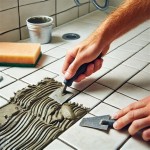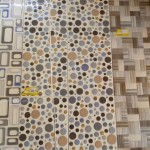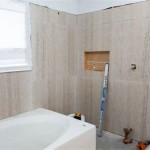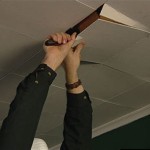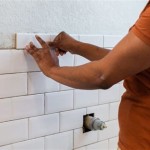Can You Put Tile On Plaster Walls In A Shower? A Comprehensive Guide
The question of whether tile can be directly applied to plaster walls in a shower is a common one, particularly for homeowners renovating older bathrooms. The answer is not a simple yes or no. The suitability of plaster as a substrate for tile in a wet environment like a shower depends on several factors, including the condition of the plaster, the type of plaster, and the preparation methods employed. A thorough understanding of these factors is crucial for a successful and long-lasting tile installation.
Plaster walls, traditionally composed of lime, sand, and water, or gypsum-based materials in more modern constructions, offer a solid and durable surface. However, their inherent properties and potential weaknesses must be carefully considered before undertaking a tiling project in a shower. Unlike cement backer board or other specifically designed tile substrates, plaster may be more susceptible to moisture damage and movement over time. Ignoring these potential pitfalls can lead to tile failure, water damage behind the walls, and costly repairs.
Assessing the Condition of the Plaster
The first and most critical step is a meticulous assessment of the existing plaster. This involves visually inspecting the walls for any signs of damage, such as cracks, crumbling, water stains, or loose areas. These indicators signal underlying problems that must be addressed before any tiling work begins. Minor hairline cracks may be acceptable with proper preparation, but significant cracking or crumbling plaster suggests structural issues that require immediate attention.
Delamination, where the plaster separates from the lath (the backing material, typically wood or metal mesh), is a particularly serious concern. This can be identified by tapping on the plaster surface. A hollow sound indicates delamination and means the plaster is no longer adequately bonded to the lath. Any loose or delaminated plaster must be removed and repaired before tiling. Attempting to tile over unstable plaster is almost certain to result in tile failure.
Water stains are another red flag, indicating past or present water leaks. Even if the leak has been addressed, the affected plaster may have been weakened and become more susceptible to future moisture damage. Areas with significant water staining should be carefully inspected and potentially replaced to ensure a sound substrate for the tile. The source of the water leak must also be permanently resolved to prevent future problems.
In addition to visual inspection, it's crucial to check the plaster's integrity by attempting to gently scrape or pick at it with a small tool. If the plaster crumbles easily or comes away in large pieces, it's too weak to support the weight of tile and the stresses of a shower environment. A strong, solid plaster surface should be resistant to such efforts and maintain its structural integrity.
Preparing the Plaster Surface for Tile
Assuming the plaster is deemed sound and in good condition, proper preparation is essential to ensure a successful tile installation. This involves cleaning the surface, applying a bonding agent, and potentially adding a waterproofing membrane.
Thorough cleaning is paramount to remove any dirt, dust, grease, or other contaminants that could interfere with the adhesion of the tile adhesive. Use a mild detergent and water to scrub the plaster surface, followed by a thorough rinsing to remove any soap residue. Allow the plaster to dry completely before proceeding to the next step.
Applying a bonding agent, such as a latex-modified primer, is critical to improve the adhesion between the plaster and the tile adhesive. These primers create a stronger bond, reducing the risk of tile separation. Follow the manufacturer's instructions carefully, as different primers may have specific application requirements. Some primers may require multiple coats or specific drying times.
Waterproofing is arguably the most crucial aspect of preparing plaster walls for a shower. While plaster can absorb some moisture, prolonged exposure to water can lead to deterioration and tile failure. Implementing a robust waterproofing system is essential to protect the plaster and ensure the longevity of the tile installation. This is typically achieved by applying a waterproofing membrane over the prepared plaster surface.
Various waterproofing membranes are available, including liquid-applied membranes and sheet membranes. Liquid-applied membranes are typically applied in multiple coats, creating a seamless, waterproof barrier. Sheet membranes are pre-formed sheets that are adhered to the wall using a special adhesive. Both types of membranes can be effective, but it's crucial to choose a product specifically designed for shower applications and to follow the manufacturer's instructions meticulously. Applying the membrane incorrectly can compromise its effectiveness and lead to water damage.
When using a liquid-applied membrane, pay particular attention to corners, edges, and penetrations (such as showerheads and faucets). These are areas where water is most likely to penetrate, so extra care is needed to ensure a complete and watertight seal. Applying reinforcing fabric in these areas can further enhance the waterproofing protection.
Choosing the Right Tile and Adhesive
The choice of tile and adhesive is also critical for a successful tile installation on plaster walls in a shower. Consider the weight and size of the tiles, as well as the specific properties of the adhesive.
Larger and heavier tiles place greater stress on the substrate and adhesive. While smaller tiles are generally more forgiving, larger tiles can create a more modern and aesthetically pleasing look. If using larger tiles, it's even more important to ensure the plaster is structurally sound and properly prepared with a robust waterproofing system. The adhesive must also be capable of supporting the weight of the tiles without sagging or detaching.
The adhesive, also known as thin-set mortar, should be specifically formulated for use in wet environments and compatible with both the tile and the plaster substrate. Latex-modified thin-set mortars are commonly recommended for shower applications due to their superior adhesion and water resistance. Read the manufacturer's instructions carefully and choose an adhesive that is appropriate for the type of tile being used (e.g., ceramic, porcelain, glass). Mixing the adhesive according to the manufacturer's specifications is also essential to ensure proper bonding.
Grout, the material used to fill the spaces between the tiles, also plays a crucial role in preventing water penetration. Epoxy grout is generally considered the best option for shower applications due to its superior water resistance and stain resistance compared to traditional cement-based grout. Epoxy grout is also less prone to cracking and crumbling, making it a more durable and long-lasting choice.
Proper installation techniques are crucial to ensuring a watertight and durable tile installation. This includes using the correct trowel size to achieve adequate coverage of the adhesive, properly spacing the tiles, and ensuring that the grout is properly sealed. Consult with a professional tile installer if you are unsure about any aspect of the installation process.
In summary, tiling over plaster walls in a shower is possible, but it requires careful assessment, thorough preparation, and the use of appropriate materials. Neglecting any of these aspects can significantly increase the risk of tile failure and water damage. When in doubt, consulting with a qualified professional is always recommended to ensure a successful and long-lasting tile installation.
Plaster Walls In The Bathroom Velvet Linen

Can You Use Plaster In A Bathroom Interior Design Amory Brown

How To Apply Plasters In Showers Stucco Italiano

How To Apply Plasters In Showers Stucco Italiano

How To Tile A Bathroom Wall Granada Cement Blog Ideas Tips And More
Plaster For Bathroom Tub Shower Wall Can I Diy It Printable Version

9 Fresh Alternatives To Bathroom Wall Tiles

Shower Room Plastering Wall Prep Advice Needed Page 1 Homes Gardens And Diy Pistonheads

Bathroom Renovation Plaster In The Suitable

Shower Waterproofing And How To Install Zellige Tile Eclectic Twist
Related Posts


